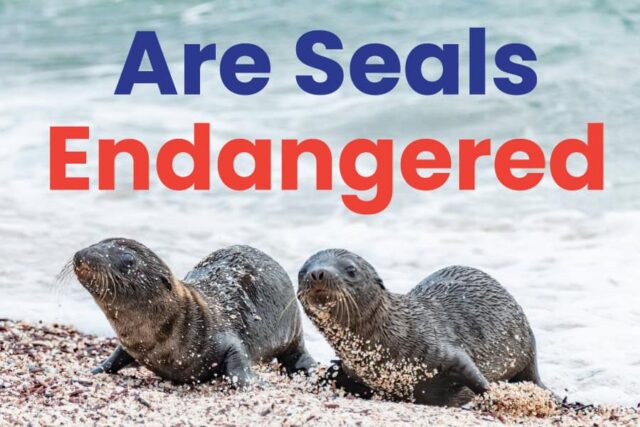Seals are iconic marine mammals found in various parts of the world, from the icy waters of the Arctic to the temperate regions of the Atlantic and Pacific oceans. With over 30 species of seals, these creatures play a critical role in marine ecosystems. However, seals face numerous challenges in the wild, raising a vital question: Are seals endangered? This question has become increasingly important as environmental changes, human activity, and other threats have led to declining seal populations in some areas. Understanding the reasons behind their potential endangerment and the efforts to protect them is crucial to ensuring their survival.
In this article, we will delve into the leading causes behind the decline in seal populations, discuss which species are most at risk, and explore the conservation strategies implemented to reverse these trends. By raising awareness of seals’ dangers, we can help promote more effective measures to protect these animals from extinction.
Whether you’re an environmentalist, a wildlife enthusiast, or someone concerned about biodiversity, the topic of endangered seals deserves attention. Throughout this article, we’ll answer pressing questions, present useful information, and highlight what can be done to support seal populations worldwide.
Are Seals Endangered?
Yes, some species of seals are considered endangered due to threats such as habitat loss, pollution, climate change, and illegal hunting. Species like the Mediterranean and Hawaiian monk seals are critically endangered. However, many conservation efforts are in place to protect seal populations, prevent further decline, and foster recovery.
What Makes Seals Endangered?
Many factors contribute to the endangered status of certain seal species. The most prevalent threat comes from human activity, which directly and indirectly impacts seal populations. Industrial fishing depletes the food sources that seals rely on, while climate change has led to the melting of polar ice caps, which serve as breeding grounds for several species. Pollution in the oceans also affects seal habitats, making it harder for them to thrive.
Habitat destruction is another leading cause. As human populations grow and industries expand, seals’ natural habitats are being encroached upon or destroyed. Coastal development, oil drilling, and marine traffic are increasing the stress on the environments seals need for breeding, feeding, and resting.
Moreover, seals are often hunted for their fur, blubber, and meat, further contributing to their dwindling numbers. Although there are international bans on the hunting of certain seal species, illegal poaching still occurs in some parts of the world. These activities have left certain species, such as the Mediterranean monk seal, critically endangered.
In addition, disease outbreaks, often exacerbated by environmental pollution, are becoming more common in seal populations. When a population is already diminished, the impact of disease can be devastating, pushing the species closer to extinction.
Lastly, climate change remains a significant concern for seals, particularly those dependent on sea ice. As ice caps melt at alarming rates, seals are losing the habitats necessary for breeding and molting. The long-term consequences of this are uncertain, but the immediate impacts are visible as seal numbers continue to fall in affected regions.
Which Seal Species Are Endangered?
Seals inhabit different regions and environments, so not all species are equally threatened. However, conservation organizations list several seal species as endangered or critically endangered.
Hawaiian Monk Seal
The Hawaiian monk seal is one of the most endangered species in the world, with only around 1,400 individuals left. These seals are native to the Hawaiian Islands and face numerous threats, including human disturbance, entanglement in fishing gear, and disease. Conservation programs are actively working to restore this species’ numbers.
Mediterranean Monk Seal
Another critically endangered seal species is the Mediterranean monk seal. Found in the Mediterranean Sea and parts of the Atlantic Ocean, fewer than 700 individuals remain. Habitat loss, pollution, and human disturbance have been the primary factors contributing to their endangered status.
Saimaa Ringed Seal
The Saimaa ringed seal is a freshwater species native to Finland’s Lake Saimaa. Its population is about 400 individuals. The melting of ice due to climate change and disturbances from human activities, such as fishing and boating, are major threats to this species.
Caspian Seal
The Caspian seal is also endangered, largely due to habitat degradation, pollution, and illegal hunting. Found in the Caspian Sea, its population has significantly declined over the past century, prompting conservation efforts to save the species.
Other At-Risk Species
Species such as the gray seal, harbor seal, and northern elephant seal have faced challenges but are now showing signs of recovery due to conservation efforts. However, they still remain vulnerable to habitat changes and human activities.
What Are the Main Threats to Seals?
- Habitat Destruction: Coastal development and industrial activity are shrinking seals’ natural habitats.
- Pollution: Oil spills, plastic waste, and chemicals in the ocean harm seals by contaminating their food sources and causing disease.
- Climate Change: Melting polar ice caps affect seals’ ability to breed and find food.
- Overfishing: Competition with commercial fisheries reduces the availability of fish for seals, leading to malnutrition.
- Illegal Hunting: Some seals are still hunted for their fur and blubber despite bans.
- Bycatch: Seals are often unintentionally caught in fishing nets, leading to injury or death.
What Conservation Efforts Are Being Made to Protect Seals?
Seal conservation efforts have been growing as awareness of their endangered status increases. Various national and international organizations have implemented measures to protect seals, focusing on habitat preservation, anti-poaching initiatives, and marine pollution control.
One of the most significant efforts has been establishing marine protected areas (MPAs), where human activity is restricted or regulated to minimize its impact on wildlife. MPAs help preserve the ecosystems that seals depend on for food and breeding, offering them a sanctuary from the pressures of fishing and coastal development.
Legal protections for seals have also been strengthened over the years. Several countries have enacted laws prohibiting the hunting of endangered seal species. The Marine Mammal Protection Act (MMPA) in the United States is one such law that safeguards seals and other marine mammals from harm caused by human activities.
Additionally, rescue and rehabilitation programs have been established to help seals injured by pollution, bycatch, or disease. Organizations like the Marine Mammal Center rescue stranded seals, nurse them back to health and release them back into the wild.
Public awareness campaigns are crucial for reducing human-seal conflict. Educational programs inform people about the importance of seals in marine ecosystems and encourage responsible behaviors such as reducing plastic use, supporting sustainable fishing, and reporting illegal poaching activities.
International collaboration is also essential in conservation efforts. Seals migrate across national borders, so coordinated action is necessary to protect them. Organizations like the International Union for Conservation of Nature (IUCN) work with governments worldwide to monitor seal populations and enforce conservation strategies.
How Can You Help Protect Seals?
Support Conservation Organizations Supporting NGOs and other conservation groups that focus on marine life protection can make a significant difference in seal conservation.
Reduce Plastic Waste
One of the easiest ways to help is by reducing your plastic use. Seals and other marine animals often mistake plastic for food or become entangled in plastic debris.
Advocate for Marine Protection
Join campaigns that advocate for the creation and expansion of marine protected areas. These areas provide safe spaces for seals to breed, rest, and hunt.
Sustainable Seafood Choices
By choosing sustainably sourced seafood, you help reduce overfishing and ensure that there is enough food in the ocean for seals and other marine species.
Avoid Disturbing Wildlife
When visiting coastal areas, ensure that you respect local wildlife guidelines. Avoid approaching seals too closely, and never interfere with their natural behaviors.
Volunteer or Donate
Consider volunteering with or donating to organizations that rescue and rehabilitate seals. Your time and resources can go a long way in supporting their efforts to save endangered seal species.
Bottom Line
Seals are endangered, but not all species face the same threat level. The outlook for many seal species could improve with continued conservation efforts, education, and global cooperation. However, their threats, from climate change to illegal hunting, remain significant. We all have a role in ensuring that seals are protected for future generations, whether through direct involvement in conservation programs or by making responsible lifestyle choices that help reduce our environmental impact.
FAQ’s
Q. What is the most endangered seal species?
A. The Hawaiian and Mediterranean monk seals are considered two of the most critically endangered species.
Q. How can we help seals from becoming extinct?
A. Supporting conservation organizations, reducing plastic waste, and advocating for marine protected areas are ways to help protect seals.
Q. Why are seals hunted?
A. Seals have historically been hunted for fur, fat, and meat, though international bans have reduced legal hunting.














